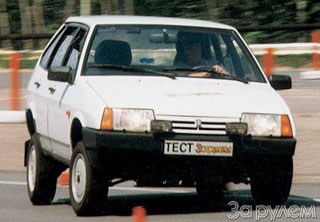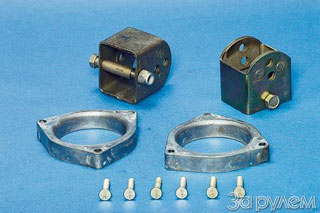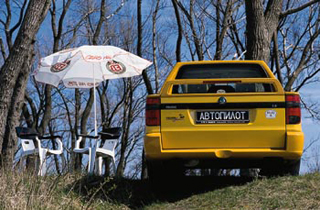Skoda Felicia 1995 test drive - 2001 -
ON TIPTOE
 It has become fashionable to raise cars now, however, like about fifteen to twenty years ago.
It has become fashionable to raise cars now, however, like about fifteen to twenty years ago. The owners of Samar are especially sinning by this. The magazine recently turned to this current topic (ZR, 1999, No. 7). Today we decided to check the academic postulates about the harmfulness of the notorious spacers. Moreover, not only nine, but also the popular Skoda-Felicia, which, due to the modest road clearance, suffers greatly on uneven Russian roads.
We buy
In search of the necessary lifting parts, we went to markets and shops and soon became the happy owners of two very similar sets of spacers (in the photo). The front are installed on the upper support of the racks, the rear - under the lower. The Skodovsky set struck with monumentality - all the details were made of whole pieces of steel and anodized. Nine spacers are simpler. Front - cast aluminum, the rear - welded. The kit for Samara cost 200 rubles. Monolithic products for the Czech car are much more expensive - about $ 80.
 Raise
Raise They managed to quickly cope with the installation of the spacers, while the front for the nine had to be adjusted with a file in the place, removing almost a millimeter of aluminum. Their manufacturers, apparently, jokes, however, are not very angry. Could make the details with steel, and even hardened - then I would have to sweat ...
At the end of everything, they checked and adjusted the mileage-disorder. For those who still decide to raise the car, we recommend that you also adjust the longitudinal angle of the wheel rotation axis - Castor. It decreases very significantly, since the car has a large slope forward. By the way, on the Skoda this parameter, like the collapse, is not adjustable, so the wheels after lifting are incorrectly, Castor becomes nearoliev, which, to put it mildly, is bad! And nothing can be done about it.
Measure
Fans of off -road driving on road cars can rejoice, but in moderation. Most of the geometric parameters affecting cross -country ability improved (see scheme), except for one, very important - entry angle. But let's in order.
The thickness of the front spacers for Samara is 22 mm, for Skoda - 28 mm. The rear include two levels of rise: Samara - 35/55 mm, felicia - 60/80 mm. In the latter case, the manufacturers clearly overdo it - Skoda began to look awkward and leaned forward too much. The same effect, although it appeared to a lesser extent on the nine. As a result, the gap under the cross-member of the rear suspension became all-terrain, but the angle of entry ... decreased. Now, approaching a high bump, there is more chances to hook it with the front bumper.
 ON THE ROAD
ON THE ROAD We removed the characteristics of low and then lifted cars on the dynamometric road of the landfill. They measured maximum speed, run, braking distance. The first two parameters allow you to evaluate the change in the aerodynamics of the car, the latter is the effectiveness of the brakes. Note that in the nine it is necessary to adjust the sorcerer - the brake forces regulator located on the beam of the rear axle. What are the results (see table): on both machines the maximum speed and run from 120 km/h decreased. Here you have the first negative effect. The aerodynamics of the raised machine deteriorates, which means that you can expect an increase in fuel consumption when moving with high speeds. The braking distance, on the contrary, was reduced due to a stronger biting that loads the front, more powerful disc brakes. At the same time, with sharp braking, extremely unpleasant scouring appeared. This applies to both Samara and Skoda. Of course, you can’t classify this effect to this effect.
The nuances of controllability
 Now let's check whether the raised cars are becoming too rolling in the turns and whether it is dangerous to drive them, as experts say. Let's say right away: during ordinary driving, no new sensations appeared, although everything happens on the road ... We will simulate an emergency situation, for which we will perform a maneuver called science a change of lane, and reserving in jargon. This is one of the standard test control tests.
Now let's check whether the raised cars are becoming too rolling in the turns and whether it is dangerous to drive them, as experts say. Let's say right away: during ordinary driving, no new sensations appeared, although everything happens on the road ... We will simulate an emergency situation, for which we will perform a maneuver called science a change of lane, and reserving in jargon. This is one of the standard test control tests. What showed the rearrangement? Standard low felicia yielded to its opponent - the low Samara - in the speed of performing the maneuver there are only - 3 km/h, but at the same time demanded much more skill and effort from the driver. Skoda showed a noticeable tendency to drift the rear axle and with great deeds responded to the actions of the steering wheel to prevent this skid. When the cars were raised, the gap increased. Although the nine showed the same result, Skodov’s motives appeared in her behavior. The car was more rocked, earlier it went to the skid, the steering wheel became not in a samarish. A professional tester coped with this. But does an ordinary driver cope with a car that has changed its character?
High Skoda began to roll even more, torn off the rear wheel from the asphalt, the tendency to drift became simply manic, and its correction, including because of the abolished castor, became problematic. As a result, the already non -inflammable result decreased by another 3 km/h.
 Other dangers
Other dangers Fans of high cars are in wait for another danger: accelerated wear or even the destruction of CV joints. Honestly, to drive the car into such a mode so that the hinge collapses, we could not at the training ground, although we tried. But the fact that the CHRUS works in a more bent state is noticeably naked eye. So the question of the durability of the drives we will leave open.
The next inconvenience is also evident. When parking, the hood of a car standing behind is completely disappeared from sight. Yes, and the headlights luminous for themselves will have to adjust it again.
Raise or not?
We will answer the question with the question - why? To make it beautiful and cool? The argument, of course, is serious, but only for frivolous people. To put wide wheels? So they are put in the hope of improving the stability and controllability of the machine - just those qualities that spacers only worsen. However, we will devote separate material to this topic. Bad road to the country, trips to picnics, hunting, fishing? This is perhaps the only significant reason. Alas, the raised car still does not become an alternate.
 P.S
P.S A week later, on both cars, the rear spacers were rearranged to the lower position. So? Less critical of them nine in this state remains. The reason is the same picnics, trips by savage on vacation, as well as borders-yami-lukes. Felicia will fall to the original state, as soon as her owner, by the way, will reach his hand - well, he does not want to pay his own safety for pleasure to get to those places where the wheel of a civilized motorist did not step.
A set of spacers for VAZ 2109 (right) and for Skoda-Felicia (left). The principle is one - the performance and the price are different. Products for Skoda are much more solid and more expensive.
Spots in the suspension - advantages and disadvantages
+ Increased road clearance, better cross -country ability, smaller braking distance.
- a decrease in maximum speed and run, increased fuel consumption at high speed, deterioration of controllability (rolls, tendency to skidding, a sluggish reaction to the actions of the steering wheel), screening during braking, limited review back.
Felicia is sometimes just dangerous.
Even without spacers, Skoda was distinguished by large rolls and a tendency to skidding.
With spacers, nine acquired some Skodov features - she began to roll more, react worse to turning the steering wheel.
Some tips to those who are not life without spacers ...
- Do not get carried away with the height of the spacers - the main moderation.
- After lifting, control and adjust the angles of the wheel installation.
- Adjust the brake forces regulator.
- Adjust the headlights.
- Do not get carried away with speed, sharp maneuvers and intensive braking.
Igor Solidov, Yuri Nechetov







Source: The magazine "Driving"








